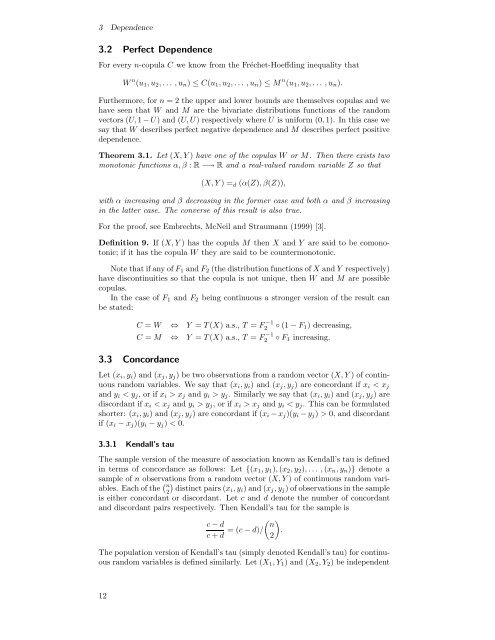Modelling Dependence with Copulas - IFOR
Modelling Dependence with Copulas - IFOR
Modelling Dependence with Copulas - IFOR
Create successful ePaper yourself
Turn your PDF publications into a flip-book with our unique Google optimized e-Paper software.
3 <strong>Dependence</strong><br />
3.2 Perfect <strong>Dependence</strong><br />
For every n-copula C we know from the Fréchet-Hoeffding inequality that<br />
W n (u 1 ,u 2 ,... ,u n ) ≤ C(u 1 ,u 2 ,... ,u n ) ≤ M n (u 1 ,u 2 ,... ,u n ).<br />
Furthermore, for n = 2 the upper and lower bounds are themselves copulas and we<br />
have seen that W and M are the bivariate distributions functions of the random<br />
vectors (U, 1 − U) and(U, U) respectively where U is uniform (0, 1). In this case we<br />
say that W describes perfect negative dependence and M describes perfect positive<br />
dependence.<br />
Theorem 3.1. Let (X, Y ) have one of the copulas W or M. Then there exists two<br />
monotonic functions α, β : R −→ R and a real-valued random variable Z so that<br />
(X, Y )= d (α(Z),β(Z)),<br />
<strong>with</strong> α increasing and β decreasing in the former case and both α and β increasing<br />
in the latter case. The converse of this result is also true.<br />
For the proof, see Embrechts, McNeil and Straumann (1999) [3].<br />
Definition 9. If (X, Y ) has the copula M then X and Y are said to be comonotonic;<br />
if it has the copula W they are said to be countermonotonic.<br />
Note that if any of F 1 and F 2 (the distribution functions of X and Y respectively)<br />
have discontinuities so that the copula is not unique, then W and M are possible<br />
copulas.<br />
In the case of F 1 and F 2 being continuous a stronger version of the result can<br />
be stated:<br />
C = W ⇔ Y = T (X) a.s., T = F2 −1 ◦ (1 − F 1 ) decreasing,<br />
C = M ⇔ Y = T (X) a.s., T = F2 −1 ◦ F 1 increasing.<br />
3.3 Concordance<br />
Let (x i ,y i )and(x j ,y j ) be two observations from a random vector (X, Y ) of continuous<br />
random variables. We say that (x i ,y i )and(x j ,y j ) are concordant if x i y j . Similarly we say that (x i ,y i )and(x j ,y j ) are<br />
discordant if x i y j ,orifx i >x j and y i 0, and discordant<br />
if (x i − x j )(y i − y j ) < 0.<br />
3.3.1 Kendall’s tau<br />
The sample version of the measure of association known as Kendall’s tau is defined<br />
in terms of concordance as follows: Let {(x 1 ,y 1 ), (x 2 ,y 2 ),... ,(x n ,y n )} denote a<br />
sample of n observations from a random vector (X, Y ) of continuous random variables.<br />
Each of the ( n<br />
2)<br />
distinct pairs (xi ,y i )and(x j ,y j ) of observations in the sample<br />
is either concordant or discordant. Let c and d denote the number of concordant<br />
and discordant pairs respectively. Then Kendall’s tau for the sample is<br />
( )<br />
c − d<br />
n<br />
c + d =(c − d)/ .<br />
2<br />
The population version of Kendall’s tau (simply denoted Kendall’s tau) for continuous<br />
random variables is defined similarly. Let (X 1 ,Y 1 )and(X 2 ,Y 2 ) be independent<br />
12
















